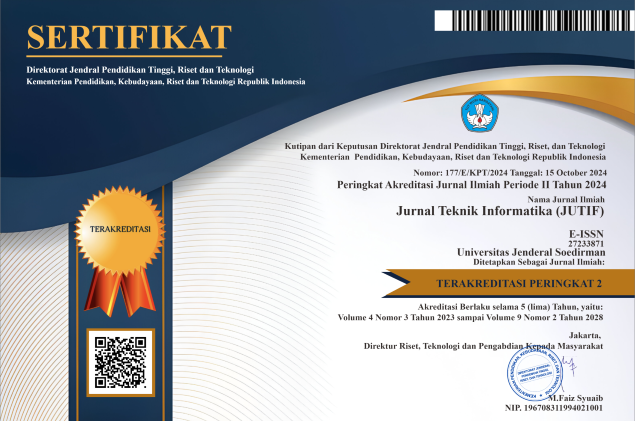DYNAMIC WEIGHT ALLOCATION IN MODIFIED MULTI-ATRIBUTIVE IDEAL-REAL COMPARATIVE ANALYSIS WITH SYMMETRY POINT FOR REAL-TIME DECISION SUPPORT
DOI:
https://doi.org/10.52436/1.jutif.2025.6.1.4170Keywords:
Decision Support System, Dynamic Weighting, S-MAIRCA, Spearman Correlation, Symmetry-PointAbstract
Decision Support Systems (DSS) have a crucial role in real-time decision-making, especially in the digital era that demands high speed and accuracy. Managing criterion weights in a dynamic environment presents significant challenges due to rapid and unpredictable changes in conditions. However, determining an accurate weight becomes difficult due to uncertainty, incomplete data, and subjective factors from decision-makers. In addition, changes in the external environment, such as market trends, regulations, or customer preferences, can affect the relevance of each criterion, thus requiring a real-time weight adjustment mechanism. The purpose of this study is to develop and explore the dynamic weight allocation method in symmetry point- multi-attributive ideal-real comparative analysis (S-MAIRCA) to support more accurate and responsive real-time decision-making in a dynamic environment. This research contributes to the understanding of how the weights of criteria can be adjusted automatically and responsively to changing conditions or new data, which increases the relevance and accuracy of decisions in a dynamic environment. The urgency of S-MAIRCA research is important because it often involves real-time, dynamic, and complex data. This development not only improves the adaptability of the S-MAIRCA method, but also contributes significantly to creating computer science-based applications that are more intelligent, flexible, and relevant to the evolving needs of the system. The results of the alternative ranking comparison using the CRITIC-MAIRCA, LOPCOW-MAIRCA, ROC-MAIRCA, and S-MAIRCA methods showed variations in the ranking order generated for each alternative using spearman correlation. The results of the correlation value of CRITIC-MAIRCA and LOPCOW-MAIRCA have a very high correlation of 0.993, which shows that these two methods provide almost identical rankings in alternative evaluation. Likewise, CRITIC-MAIRCA and S-MAIRCA had a high correlation of 0.979, signaling a strong similarity in ranking results despite slight differences in the approaches used by the two methods. The results of the application of the MAIRCA-S method in the development of DSS based on real-time data have a significant impact on improving the speed, accuracy, and adaptability of decisions. MAIRCA-S strengthens the validity of decision results by considering a variety of attributes on a more comprehensive scale, providing added value in the development of DSS for various industrial sectors.
Downloads
References
A. R. Mishra, P. Rani, F. Cavallaro, I. M. Hezam, and J. Lakshmi, “An Integrated Intuitionistic Fuzzy Closeness Coefficient-Based OCRA Method for Sustainable Urban Transportation Options Selection,” Axioms, vol. 12, no. 2, p. 144, Jan. 2023, doi: 10.3390/axioms12020144.
I. Granado, L. Hernando, Z. Uriondo, and J. A. Fernandes-Salvador, “A fishing route optimization decision support system: The case of the tuna purse seiner,” Eur. J. Oper. Res., vol. 312, no. 2, pp. 718–732, 2024, doi: https://doi.org/10.1016/j.ejor.2023.07.009.
L. Siciliani, V. Taccardi, P. Basile, M. Di Ciano, and P. Lops, “AI-based decision support system for public procurement,” Inf. Syst., vol. 119, p. 102284, Oct. 2023, doi: 10.1016/j.is.2023.102284.
H. Sulistiani, S. Setiawansyah, A. F. O. Pasaribu, P. Palupiningsih, K. Anwar, and V. H. Saputra, “New TOPSIS: Modification of the TOPSIS Method for Objective Determination of Weighting,” Int. J. Intell. Eng. Syst., vol. 17, no. 5, pp. 991–1003, Oct. 2024, doi: 10.22266/ijies2024.1031.74.
S. Chakraborty, P. Chatterjee, and P. P. Das, “Multi-Attributive Ideal-Real Comparative Analysis (MAIRCA) Method,” in Multi-Criteria Decision-Making Methods in Manufacturing Environments, Apple Academic Press, 2024, pp. 289–296.
F. Ecer, A. Böyükaslan, and S. Hashemkhani Zolfani, “Evaluation of Cryptocurrencies for Investment Decisions in the Era of Industry 4.0: A Borda Count-Based Intuitionistic Fuzzy Set Extensions EDAS-MAIRCA-MARCOS Multi-Criteria Methodology,” Axioms, vol. 11, no. 8, p. 404, Aug. 2022, doi: 10.3390/axioms11080404.
S. Hadian, E. Shahiri Tabarestani, and Q. B. Pham, “Multi attributive ideal-real comparative analysis (MAIRCA) method for evaluating flood susceptibility in a temperate Mediterranean climate,” Hydrol. Sci. J., vol. 67, no. 3, pp. 401–418, Feb. 2022, doi: 10.1080/02626667.2022.2027949.
S. Riahi, A. Bahroudi, M. Abedi, and S. Aslani, “Hybrid outranking of geospatial data: Multi attributive ideal-real comparative analysis and combined compromise solution,” Geochemistry, vol. 82, no. 3, p. 125898, Sep. 2022, doi: 10.1016/j.chemer.2022.125898.
T. ÖZTAŞ and G. Z. ÖZTAŞ, “Innovation Performance Analysis of G20 Countries: A Novel Integrated LOPCOW-MAIRCA MCDM Approach Including the COVID-19 Period,” Veriml. Derg., pp. 1–20, Jan. 2024, doi: 10.51551/verimlilik.1320794.
M. C. Joe Anand, K. Kalaiarasi, N. Martin, B. Ranjitha, S. S. Priyadharshini, and M. Tiwari, “Fuzzy C-Means Clustering with MAIRCA -MCDM Method in Classifying Feasible Logistic Suppliers of Electrical Products,” in 2023 First International Conference on Cyber Physical Systems, Power Electronics and Electric Vehicles (ICPEEV), Sep. 2023, pp. 1–7. doi: 10.1109/ICPEEV58650.2023.10391835.
S. Hashemkhani Zolfani, F. Ecer, D. Pamučar, and S. Raslanas, “NEIGHBORHOOD SELECTION FOR A NEWCOMER VIA A NOVEL BWM-BASED REVISED MAIRCA INTEGRATED MODEL: A CASE FROM THE COQUIMBO-LA SERENA CONURBATION, CHILE,” Int. J. Strateg. Prop. Manag., vol. 24, no. 2, pp. 102–118, Jan. 2020, doi: 10.3846/ijspm.2020.11543.
M. S. Almhanna, T. A. Murshedi, A. M. Al-Salih, and R. M. Almuttairi, “Dynamic Allocation of Weights Using the Minimally Connected Method to Augment Load Equilibrium in Distributed Systems,” Int. J. Intell. Eng. Syst., vol. 17, no. 1, pp. 343–356, Feb. 2024, doi: 10.22266/ijies2024.0229.31.
H. Li and T. Zhao, “A dynamic similarity weighted evolving fuzzy system for concept drift of data streams,” Inf. Sci. (Ny)., vol. 659, p. 120062, 2024, doi: https://doi.org/10.1016/j.ins.2023.120062.
D. S. Maltseva and R. O. Popovych, “Point-symmetry pseudogroup, Lie reductions and exact solutions of Boiti–Leon–Pempinelli system,” Phys. D Nonlinear Phenom., vol. 460, p. 134081, Apr. 2024, doi: 10.1016/j.physd.2024.134081.
I. M. Hezam, N. R. D. Vedala, B. R. Kumar, A. R. Mishra, and F. Cavallaro, “Assessment of Biofuel Industry Sustainability Factors Based on the Intuitionistic Fuzzy Symmetry Point of Criterion and Rank-Sum-Based MAIRCA Method,” Sustainability, vol. 15, no. 8, p. 6749, Apr. 2023, doi: 10.3390/su15086749.
P. Rani, A. R. Mishra, D. Pamucar, J. Ali, and I. M. Hezam, “Interval-valued intuitionistic fuzzy symmetric point criterion-based MULTIMOORA method for sustainable recycling partner selection in SMEs,” Soft Comput., 2023, doi: 10.1007/s00500-023-08189-7.
A. R. Mishra, P. Rani, D. Pamucar, and V. Simic, “Evaluation and Prioritization of Sustainable Enterprise Resource Planning in SMEs Using q-Rung Orthopair Fuzzy Rough Set-Based Decision Support Model,” IEEE Trans. Fuzzy Syst., vol. 32, no. 5, pp. 3260–3273, 2024, doi: 10.1109/TFUZZ.2024.3374799.
J. Úradníček, M. Musil, Ľ. Gašparovič, M. Páleník, and M. Bachratý, “Enhancing reliability in estimating modal parameters for automotive disk Brakes: A comprehensive approach using the Eigensystem Realization algorithm and additional criteria,” Mech. Syst. Signal Process., vol. 224, p. 112069, 2025, doi: https://doi.org/10.1016/j.ymssp.2024.112069.
H. Ren, X. Zhuang, X. Fu, Z. Li, and T. Rabczuk, “Bond-based nonlocal models by nonlocal operator method in symmetric support domain,” Comput. Methods Appl. Mech. Eng., vol. 418, p. 116230, 2024, doi: https://doi.org/10.1016/j.cma.2023.116230.
A. Saha et al., “Fermatean Fuzzy Dombi Generalized Maclaurin Symmetric Mean Operators for Prioritizing Bulk Material Handling Technologies,” Cognit. Comput., vol. 16, no. 6, pp. 3096–3121, 2024, doi: 10.1007/s12559-024-10323-y.
W. A. Faridi, A.-M. Wazwaz, A. M. Mostafa, R. Myrzakulov, and Z. Umurzakhova, “The Lie point symmetry criteria and formation of exact analytical solutions for Kairat-II equation: Paul-Painlevé approach,” Chaos, Solitons & Fractals, vol. 182, p. 114745, 2024, doi: https://doi.org/10.1016/j.chaos.2024.114745.
M. W. Arshad, S. Setiawansyah, R. R. Suryono, and Y. Rahmanto, “Combination of CRITIC Weighting Method and Multi-Atributive Ideal-Real Comparative Analysis in Staff Admissions,” Explorer (Hayward)., vol. 4, no. 2, pp. 77–86, 2024, doi: 10.47065/explorer.v4i2.1428.
S. H. Hadad, S. Subhan, S. Setiawansyah, M. W. Arshad, A. Yudhistira, and Y. Rahmanto, “COMBINATION OF LOGARITHMIC PERCENTAGE CHANGE-DRIVEN OBJECTIVE WEIGHTING AND MULTI-ATTRIBUTIVE IDEAL-REAL COMPARATIVE ANALYSIS IN DETERMINING THE BEST PRODUCTION EMPLOYEES,” J. Tek. Inform., vol. 5, no. 3, pp. 843–853, 2024, doi: 10.52436/1.jutif.2024.5.3.2057.
H. T. Dung, D. T. Do, and V. T. Nguyen, “Comparison of Multi-Criteria Decision Making Methods Using The Same Data Standardization Method,” Strojnícky časopis - J. Mech. Eng., vol. 72, no. 2, pp. 57–72, Nov. 2022, doi: 10.2478/scjme-2022-0016.
S. Setiawansyah, S. H. Hadad, A. A. Aldino, P. Palupiningsih, G. Fitri Laxmi, and D. A. Megawaty, “Employing PIPRECIA-S weighting with MABAC: a strategy for identifying organizational leadership elections,” Bull. Electr. Eng. Informatics, vol. 13, no. 6, pp. 4273–4284, Dec. 2024, doi: 10.11591/eei.v13i6.7713.


























